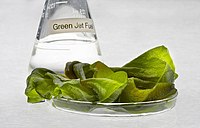
Photo from wikipedia
Abstract Challenges regarding microalgal cultivation need to be solved in order to enhance microalgae potential as a feedstock for biofuel, bioenergy, and bioproducts. The optimization of the operating strategy in… Click to show full abstract
Abstract Challenges regarding microalgal cultivation need to be solved in order to enhance microalgae potential as a feedstock for biofuel, bioenergy, and bioproducts. The optimization of the operating strategy in high rate algal ponds treating wastewater still requires research on microalgal ecosystem response to variations in nutrients availability. For this reason, the aim of this study was to determine the effect of CO2 addition on microalgal population diversity and wastewater treatment performance. To this end, batch and continuous experiments were carried out in an experimental plant constituted by four high rate algal ponds (500 L each) treating urban wastewater with and without pH regulation. As expected, CO2 addition induced a significant increase in biomass concentration (between 66 and 100%). Moreover, a positive effect on microalgal biomass concentration was observed, reducing the effect of the variation in influent wastewater characteristics. Concerning the microalgal populations, the variation of inorganic carbon availability induced a shift in the dominant microalgae species. In spite of this, no variations were observed in terms of wastewater treatment efficiency. Taking together, this study highlighted the positive effect of CO2 addition to increase biomass production and control microalgae species in high rate algal ponds treating wastewater.
Journal Title: Journal of CO2 Utilization
Year Published: 2018
Link to full text (if available)
Share on Social Media: Sign Up to like & get
recommendations!